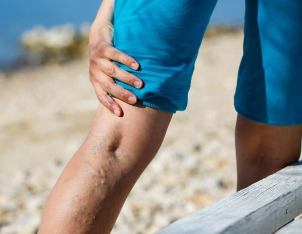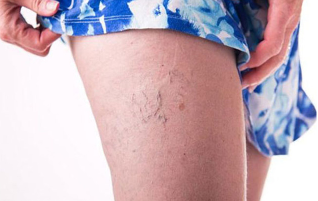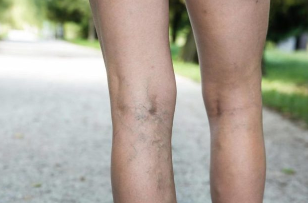The article varicose veins in the legs. We are going to talk about the symptoms and causes of the disease, the forms of treatment.
What are varicose veins
Varicose veins — a disease that occurs due to the distention of the peripheral veins beneath the skin. In the majority of cases, the disease manifests itself on the surface of the muscles of the legs, and the veins take on a hue of blue, are winding and hilly.
Also the formation of the nodes and the destruction of the valvular apparatus, causing the flow of blood in the veins broken. When you close the flaps of the valves when the problem starts. The blood is not able to get up, as often happens, and veins because of its stagnation under the pressure.
To the high pressure of the blood stretches the walls of the veins, which are of different thickness. The blood vessels are stretched and their edges pressed against the dermis and become visible. For this reason, there is a typical spider veins. If the container is visible through the dermis layer, which speaks of its weakness. The thickness of the veins, the more visible the color blue. Formed nodules, which are clearly visible on the legs.

Varicose veins affect one out of every 4 people on the planet. An important factor in the development of the disease is the lack of development of connective tissue. For the formation of the development of the varicose veins need predisposing conditions.
According to the statistics, this pathology that suffers the 20% of the world population and 50% of patients with an early stage of the disease are not even aware of their disease. Most often, the varicose veins will suffer the fairer sex.
How dangerous are varicose veins
The main danger of varicose veins lies in the appearance of complications of the disease, such as:
- Phlebitis is characterized by the formation of inflammatory processes in the internal face of the blood vessels. The skin acquires a hue red, and any touch to it hurts. If at the same time, swelling of the veins several, the health of the person deteriorates. In the case of the early beginning of the treatment, the disease develops in the thrombosis.
- As a result of thrombophlebitis occur blood seal, in other words, blood clots. To determine the exact diagnosis ultrasound, angio-ct, ultrasound, reovasography. Externally you can see the redness and seal in the area of the inflammation of the vein. The disease is sometimes accompanied by a slight increase in body temperature. If the clots occur in the deep veins, then, the patient begins a threat mortal. In order to avoid death, urgent need of surgery.
- Thrombosis is a complication of varicose veins, it is very difficult to identify because of the location of the formation of blood clots, as that can form in the deep veins without inflammation. After some time, they observe the formation of a thrombus by signs external, for example, serious or inflammation of the affected veins. In the area of the skin where there was a clot of blood, the dermis is of a red shade with blue shimmer.
- Trophic ulcers — the disease arises due to an insufficiency of the blood circulation, which further leads to the disruption of the tissues in the body. Minor Trauma can cause the spread of ulcers in the Cinnamon. Often the complications are accompanied by the formation of dermatitis and infectious processes.
To avoid serious complications, patients with venous insufficiency should take seriously their health, to visit phlebologist.
The symptoms of varicose veins in the legs
The first symptoms of varicose veins can be gently expressed, that is to say:
- thin vascular mesh acquires a blue-purple hue;
- fatigue, itching, pain and burning feeling in the legs, towards evening;
- numbness and muscle twitching at night.
With the development of changes in vessels vein symptoms worsen, because of this:
- the dermis in areas of varicose veins is made more coarse, that flakes and is covered with patches of blue;
- pain in the calf are more intense and be more regular;
- occur the venous nodes, with the touch of which causes pain.
Stage
The Experts distinguish 4 stages of the disease:
- The first stage is the almost complete absence of complaints, with the exception of minor cosmetic irregularities.
- The second stage — the appearance of heavy legs, slight swelling, irregular night cramps calf muscle.
- The third stage is the formation of spots of red, blue and then brown, thickening of the skin and mild swelling in the legs, swelling. The change of color indicates the progression of the disease, the need to start therapeutic measures.
- The fourth stage, thrombophlebitis and venous ulcers, while ignoring treatment. Ulcers formed in any injury to eliminate them is almost impossible.
Varicose veins in the legs of women
According to statistics, varicose veins disease is diagnosed in women 4 times more often than men. While varicose veins can occur in both girls and adult women.
One of the main factors of the disease in women is weight gain during menopause. This is due to the effect of the hormones (progesterone, estrogen) that reduce the tone of the veins.
Genetic influence in the development of the disease is not fully understood, but the 25% of respondents had family members who suffered from the disease.
During pregnancy
Varicose veins during pregnancy due to the influence of the factors on the female body:

- the increase in the volume of blood;
- the increase of the uterus, the compression of the retroperitoneal veins;
- hormonal changes, increased levels of progesterone;
- the increase of the intra-abdominal pressure in the process of delivery.
The disease during pregnancy develops in the first few months. Clinical symptoms begin to appear in the course of the second quarter.
Varicose veins in men legs
The main factors in the appearance of varicose veins in the legs in men are:
- Not;
- great physical effort;
- the abuse of alcohol beverages;
- constipatio;
- an unbalanced diet;
- the lack of exercise;
- weight lifting.
The men's work is often associated with physical activity. Regular stress can lead to stenosis of the saphenous vein.
Another factor in the development of the disease is the consumption of high calorie fatty foods and inadequate intake of Niacin and omega-3.
The treatment of the disease happens in the same way as women.
Treatment of varicose veins in the legs
Effective therapy of varicose veins in the legs have to solve certain problems:
- removal of varicose veins syndrome;
- the elimination of signs of the disease;
- prevention of recurrence.
The first problem is solved with the help of drug therapy and surgical intervention. Conservative treatment is aimed at eliminating the signs of the disease (drug therapy and compression), and prevention (physical therapy, elastic compression).
In the initial phase of the disease apply conservative treatment:
- the medication that the doctor prescribes (anticoagulants and phleboprotector);
- local use of gels and ointments;
- elastic compression;
- Physical therapy and exercises;
- proper nutrition and a healthy lifestyle.
The compression, conservative treatment is mandatory in all stages of the disease. When you use compression tights are able to eliminate stasis of blood, and to create good conditions for the microcirculation blood vessels. T-shirts with the optimal pressure selected, based on the extent of the varicose veins:
- Class 1 — the initial phase of the disease;
- Class 2 — varicose veins syndrome of "tired legs";
- Class 3 — the presence of complications of the disease.
Folk remedies
Folk medicine offers a number of tools, which are aimed at reducing the symptoms of the disease and the elimination of pain. Below are some of the most effective means that you can cook yourself at home.
Compress

Ingredients:
- black bread — 1 slice;
- camphor oil — 20 ml;
- the fruits of the horse chestnut — 50 g.
- Preparation: Spread bread with butter, on top sprinkle nuts, chestnuts.
- Use: the composition is the result of applying it to the swelling of Vienna and fix with a bandage elastic, leave the poultice during the night.
- Effect: the Elimination of pain after 10 sessions.
Apple cider vinegar for varicose veins of the legs
Every day at night RUB vinegar on inflamed areas of the skin. The duration of treatment is 30 days. You can carry out the procedure in the morning, but after that, you should go to sleep for an hour.
To enhance the effect of drinking Apple cider vinegar diluted in water with honey on an empty stomach, 30 minutes before a meal. The duration of treatment is 1 month.
Apple cider vinegar, diluted in water, you can apply a lotion for inflammation of the veins. To do this, dissolve in a glass of water, 2 tablespoons d'. vinegar, dampen a clean part of the cloth and apply to the affected vein. Do the procedure two hours before you go to sleep.
Background of varicose veins in the legs
Medical therapy should undergo courses of 2 times a year for 2-3 months. For the treatment used phleboprotector that eliminate the symptoms of the disease, increase the tone of veins, prevent the occurrence of inflammation in the walls of blood vessels and improves the microcirculation blood vessels.
In phlebology practice successfully used the drug on the basis of flavonoids (substances that are present in the plant organisms). For a quick and effective elimination of the symptoms ointments and gels for local purposes.
Drug therapy is not able to eliminate the disease, but slows down the progression of the disease.
Prevention
To prevent the formation of varicose veins use the following guidelines:
- special use venotonics;
- do not throw a leg over the other while sitting;
- daily clean the intestine of harmful substances, prevent the formation of constipatio;
- take breaks when foot work, let your feet relax;
- follow the diet, avoid the increase of weight, minimize the consumption of salt;
- if you have to use compression tights;
- limit the intake of alcoholic drinks and tobacco products;
- possibly spending more time in the fresh air;
- do self-massage to stop using vegetable and essential oils;
- see your doctor regularly.























